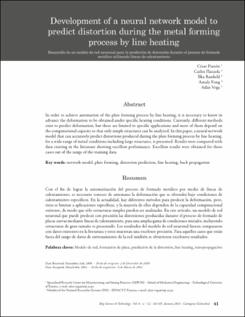Mostrar el registro sencillo del ítem
Development of a neural network model to predict distortion during the metal forming process by line heating
| dc.contributor.author | Pinzón, César | |
| dc.contributor.author | Plazaola, Carlos | |
| dc.contributor.author | Banfield, Ilka | |
| dc.contributor.author | Fong, Amaly | |
| dc.contributor.author | Vega, Adán | |
| dc.date.accessioned | 2017-08-23T17:00:01Z | |
| dc.date.accessioned | 2017-08-23T17:00:01Z | |
| dc.date.available | 2017-08-23T17:00:01Z | |
| dc.date.available | 2017-08-23T17:00:01Z | |
| dc.date.issued | 2013-01 | |
| dc.date.issued | 2013-01 | |
| dc.identifier.uri | http://ridda2.utp.ac.pa/handle/123456789/2864 | |
| dc.identifier.uri | http://ridda2.utp.ac.pa/handle/123456789/2864 | |
| dc.description | In order to achieve automation of the plate forming process by line heating, it is necessary to know in advance the deformation to be obtained under specific heating conditions. Currently, different methods exist to predict deformation, but these are limited to specific applications and most of them depend on the computational capacity so that only simple structures can be analyzed. In this paper, a neural network model that can accurately predict distortions produced during the plate forming process by line heating, for a wide range of initial conditions including large structures, is presented. Results were compared with data existing in the literature showing excellent performance. Excellent results were obtained for those cases out of the range of the training data. | en_US |
| dc.description.abstract | In order to achieve automation of the plate forming process by line heating, it is necessary to know in advance the deformation to be obtained under specific heating conditions. Currently, different methods exist to predict deformation, but these are limited to specific applications and most of them depend on the computational capacity so that only simple structures can be analyzed. In this paper, a neural network model that can accurately predict distortions produced during the plate forming process by line heating, for a wide range of initial conditions including large structures, is presented. Results were compared with data existing in the literature showing excellent performance. Excellent results were obtained for those cases out of the range of the training data. | en_US |
| dc.language | eng | |
| dc.language.iso | eng | en_US |
| dc.rights | https://creativecommons.org/licenses/by-nc-sa/4.0/ | |
| dc.rights | info:eu-repo/semantics/openAccess | |
| dc.subject | network model | en_US |
| dc.subject | plate forming | en_US |
| dc.subject | distortion prediction | en_US |
| dc.subject | line heating | en_US |
| dc.subject | back propagation | en_US |
| dc.subject | network model | |
| dc.subject | plate forming | |
| dc.subject | distortion prediction | |
| dc.subject | line heating | |
| dc.subject | back propagation | |
| dc.title | Development of a neural network model to predict distortion during the metal forming process by line heating | en_US |
| dc.type | info:eu-repo/semantics/article | |
| dc.type | info:eu-repo/semantics/publishedVersion |
